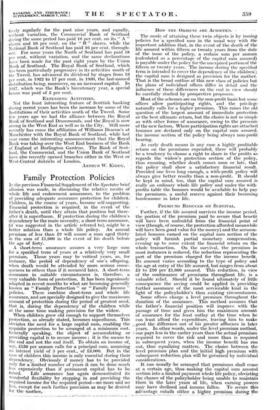Banking in Scotland
ALTHOUGH, in- the main, general conditions affecting banking profits in Scotland have not differed vastly from those south of the Tweed, there have nevertheless been some points of difference, and it is a little difficult to make a fair comparison if only for the reason, among others, that the accounts are made up at somewhat different dates from those of the English Institutions. With the exception of the Clydesdale and North of Scotland Bank, practically all of the balance sheets of the Scottish banks are made up at varying dates, but not at the end of the year as in this country. Even after making allowance for that fact, however, I am inclined to think that if comparison had to be made be- tween the Scottish and English Institutions in recent years, it would, on the whole, be favourable to Scot- land in the matter of steadiness in banking profits. To some extent, of course, this may be due to the banks working in less disturbed areas, though in the Glasgow and Clyde districts there has, of course, been much industrial depression. It may be doubted, how- ever, whether- the Scottish banks have had such heavy losses as those which have fallen during successive years upon the English banks in connexion with the trade depression. On the other hand, and to be perfectly fair, this may be due in some part to the fact that during a period of, say, ten years, when English banks were lending " freely—and perhaps too freely—to various industries, the Scottish banks were too much inclined to lock up a great proportion of the funds in gilt-edged in- vestments, rather, perhaps, to the detriment of industry. Latterly, however, there has been more expansion.
An examination of the figures of eight leading Scottish banks shows that Deposits, which in 1928 aggre- gated £248,000,000, expanded to £250,000,000 in the following year, and to £254,000,000 in 1980. As regards the Loans and Advances there was quite a jump in 1929 from £124,000,000 to £181,000,000, but even last year the set-back was only to about £128,500,000.
PROFITS.
Again, if the profits of the banks are taken into con- qideration„ a steady progression is noticeable. Over the past decade there is an almost universal advance, but, comparing the results for 1980 with 1929, the net profits of the Bank of Scotland merely declined by about £8,000, those of the British Linen by £4,000, and of the National Bank of Scotland by £4,000. On the other hand, Clydes- dale profits rose by about /5,000, Commercial of Scotland by £22,000, the North of Scotland by £4,000, the Royal Bank of Scotland by £29,000, and the Union Bank of Scotland_ by_ £8,000. Dividend distributions have also been exceedingly well maintained. As regards the Bank of. Scotland, there has been a recovery in recent years from the previous depression under which the dividend -had been reduced to 16 per cent. It was raised, however, in 1928 to 11 per cent., and for the last two years has bto.: at the_rnte_ofMper cent. The British Linen Bank -and--the Clydesdale have paid•18 and is per cent. respec- ti% ely regularly for the past nine years, and equally, ;without variation, the Commercial Bank of Scotland during the same period has paid 16 per cent. on its " A " shares and 10 . per cent. on the " B_" _shares, while the National Bank of Scotland has paid 16 per cent. through- out. For some years the North of Scotland has paid 18 per cent.. without variation, and the same declarations have been made for the past eight years by the Union Bank of Scotland. The Royal Bank of Scotland, which has been particularly progressive in its activities south of the Tweed, has advanced its diVidend by stages from 13 per cent. in 1922 to 17 per cent. in 1930, the last-named distribution being, moreover, on an increased capital. In 1927, which was the Bank's bicentenary year, a special bonus was paid of 5 per cent.
EXTENDING ACTIVITIES.
Not the least interesting feature of Scottish banking during recent years has been the increase by some of the Institutions of their activities south of the Tweed. Some few years ago we had the alliance between the Royal Bank of Scotland and Drummonds, and the Royal is now strong in the West End as well as in the City. Still more recently has come the affiliation of Williams Deacon's at Manchester with the Royal Bank of Scotland, while last year came the interesting announcement that the Royal Bank was taking over the West End business of the Bank of England at Burlington Gardens. The Bank of Scot- ; land, the Commercial, and the Union Bank of Scotland have also recently opened branches either in the West or West-Central districts of London.
ARTHUR W. KIDDY.



























































 Previous page
Previous page